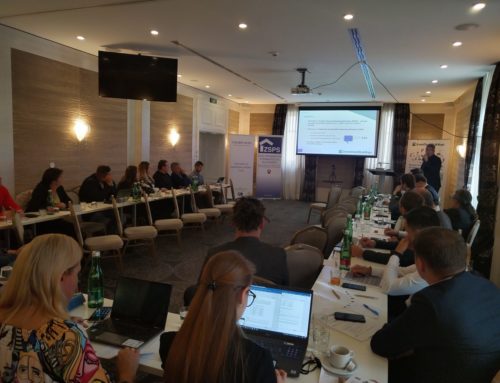On 29 September 2022, the third meeting of the Slovak Round Table took place in Bratislava. At the meeting, a number of measures were discussed and approved in the areas of financing the development and implementation of innovations in the construction sector, participatory financing, energy poverty and energy communities.
Measure 1: Changing societal priorities towards innovation for climate neutrality
Achieving climate neutrality is a watershed change that requires a fundamental rethink of societal priorities and their translation into the national budget and the allocation of EU funds in operational programmes. The share of investment and non-investment expenditure to achieve climate neutrality should be greater than 60% and should grow year-on-year to set an example for the private sector, including the financial sector and sectors regulated by the EU taxonomy. Investment in the carbon economy, including in science, research, development, investment promotion (direct or indirect) and carbon fuel use should be curtailed.
Measure 2: Promoting innovation to increase labour productivity in the construction sector and the industrialisation of construction production
Prepare and implement an innovation programme to increase labour productivity in the construction sector by rebuilding the sector around innovations in materials, construction products, equipment and processes, as well as leveraging the digitisation of the sector. These are the key factors driving new business models that ensure sustainable housing valuations (through ownership or rental). This process is accelerating with the progressive application of new technological breakthroughs in areas such as artificial intelligence, robotics, the Internet of Things (IoT), machine-to-machine (M2M) communications, big data analytics, 3-D printing, nanotechnology, materials science and energy storage.
In the medium term, these innovations should lead to a “supply-side breakthrough” with long-term efficiency and productivity gains, allowing for fair pricing of the costs of construction and living in buildings with a positive energy balance and zero emissions (resulting from energy renovation of existing buildings or construction of new ones). While the research community is aware of the opportunities that these innovations can bring, there is little knowledge on the ground and little appetite to pursue innovation along the building construction and renovation value chain. Conventional approaches will not be sufficient, as underlined by the European Green Deal, which emphasises experimentation and working across sectors and disciplines to innovate in support of its objectives.
Measure 3: Support the creation of an ecosystem for the use of modular technology in the construction of new buildings and the renovation of existing buildings
One of the innovations leading to increased labour productivity in the construction sector is modular construction, which has already been used in the construction of new energy efficient buildings as well as in the renovation of existing buildings, showing high levels of energy efficiency. However, modular construction is also successfully facing other contemporary challenges, including the challenges of energy transformation and the need to increase circularity in the construction industry.
Modular construction is a process in which buildings are manufactured off-site in factories, under strict quality control, but using the same building codes and standards as conventional construction methods. These buildings are produced in modules or small parts that are transported to the site and assembled.
Modular construction is a sustainable, efficient, cost-effective and innovative technique to consider when designing a project. The advantages of this construction method include:
- Modular building projects are completed 30-50% faster than projects with conventional construction methods. This is because modular construction can take place simultaneously with site work and foundation work.
- 60-90% of construction work is carried out in an enclosed factory environment, thus mitigating the impact of adverse weather. With conventional construction methods, work often has to be completely suspended for days with adverse weather conditions.
- Off-site construction allows for more effective enforcement of quality and safety guidelines. Building materials are protected from the weather during all phases of construction, which is a common cause of imperfections in outdoor projects. Modular buildings are completed to the same codes, regulations, and materials as conventional buildings.
- Module manufacturing enables the industrialisation of craftsmanship using robotics, automation, digitalisation and other cutting-edge innovations that, among other things, lead to improved working conditions for employees, making it possible to attract young people with higher ambitions and talent to the sector.
- Many modular buildings can be disassembled and relocated for new purposes, reducing the demand for raw materials and the energy required for construction. Although permanent modular construction has been used in the project, the renewal of materials and modules is easier than in a conventional building.
- Waste is eliminated through recycling and inventory control. Building materials are also protected from the weather as everything is stored in the factory. The modular design also makes it easier for construction workers to prevent waste because there is more control over project conditions.
- Manufacturer-controlled settings allow materials to remain dry during all phases of construction. Therefore, the level of trapped moisture in new construction is reduced, improving air quality. This helps control mould, mites and other organisms that thrive on moisture.
- Working indoors allows for a safer environment, reducing the risks and hazards found on construction sites. With conventional construction methods, work often has to be carried out at heights or in awkward positions where accidents are more likely.
- Modular buildings are generally stronger than site-built structures because each module is designed to withstand transportation and lifting. Once connected, the modules are securely joined together to form a complete integrated assembly.
- Since approximately 80% of the work is done off-site, the modular design allows entrepreneurs (building owners) to continue working during renovations, reducing business interruption. Modular construction has also reduced disruption to buildings around the site.
- Greater environmental sustainability is ensured by the fact that, in addition to reducing waste, modular construction leads the market in the use of eco-friendly materials. A wider range of materials is available when the construction process can be completed under controlled factory conditions.
- Affordability is a key feature of modular construction. When multiple similar pieces are produced at the same time, cost and time savings are achieved with economy of scale. Modular construction is particularly useful for projects with many buildings of the same design, as modules can be produced in series.
- Improves the acoustic performance of the building as the modules are designed as independent units and can be soundproofed to block noise when assembled.
However, modular construction requires a strong material and technical backing, which requires high initial costs. Also, the risk in the process of promotion in the local market is high. For this reason, it is essential to support the building of the necessary ecosystem using EU funds for the transition to climate neutrality from operational programmes as well as to support the involvement of Slovak institutions in European projects aimed at the development of modular construction.
Measure 4: Promoting Twin Green and Digital Growth in the construction sector
Serious societal challenges such as affordable housing, energy poverty and limited capacity to implement digital technologies need to be addressed, and digitalisation represents an opportunity to accelerate the green transformation of the construction sector.
The digitalisation of the green transformation process in the construction sector is based on 5 fundamental pillars:
- Low carbon and durable construction, which is an important driver of ecologization of new buildings. Green architecture, engineering and construction require information on the so-called grey energy contained in buildings (i.e. the energy associated with the production of building materials). They have to take into account many properties of the materials and components used, such as their energy efficiency, their reparability and their end-of-life scrapping. Building design and construction methods must integrate resilience to extreme events to avoid premature decay and loss of building functionality. Digital tools can help solve these problems at the design stage. For example, BIM (Building Information Modelling) can analyse the long-term implications of design decisions and can help to reduce the environmental impact of a building during the construction and operational phases. One-stop-shops can support users in complex decision-making processes and provide related services such as financing.
- Building renovation is the key to making existing buildings greener. By preserving as many of the original structural elements as possible, the grey energy contained in the building material is also preserved. For in-depth renovations, thermal and acoustic insulation and the airtightness of the building envelope are crucial. Another key element is the introduction of new and efficient space heating and cooling systems with intelligent technologies to automate building control systems. Digital tools, such as digital building logs, can facilitate the renovation of buildings and the recyclability of materials from old buildings.
- Reduced energy consumption during operation, especially during power peaks, can provide a stabilizing function for the overall power system. Heating, cooling, ventilation and lighting systems can be adaptively controlled to reduce energy consumption while maintaining the same level of comfort for occupants. Building automation and control systems are based on sensors that recognise building occupants and their requirements and help to proactively manage energy-consuming appliances.
- Low carbon heating and cooling reduces emissions and pollution during the operational phase of the building lifecycle. Electrification (e.g. using heat pumps instead of oil or gas heating) is the key to sustainable heating. In addition, photovoltaics added or integrated into a building are a renewable source of electricity with high potential for the future.
- Reduced demand for building space reduces the environmental impact of building construction and operation. Options for reducing the footprint of buildings include reducing the need for space and increasing the intensity of use of existing buildings. Digital platforms can enable more seamless sharing of space. Last but not least, small houses and apartments provide opportunities to reduce the need for space.
The development of solutions under the pillars defined above needs to be supported by a structured innovation support programme to accelerate the green transformation and exploit the synergies of green and digital growth.
Measure 5: Supporting building owners and communities in cities and towns to retrofit buildings to the level of energy-positive buildings and buildings and community projects aimed at decarbonising energy in buildings
Building owners, such as municipalities and cities, entrusted with a significant stock of public buildings, and condominium owners (homeowners associations) have a key role to play in delivering energy transformation, with a unique mandate for their assets and a unique power to convene actors along the value chain. However, these owners have acquired property assets that they have very limited (if any) financial resources to maintain. Therefore, a significant barrier to increased renovation in both the public and private sectors today is the creation and long-term maintenance of the financial and technical capacity to develop projects.
The renovation wave of the European Green Deal aims to double the renovation rate of buildings by 2030, which also requires large investments in the stock of public and private buildings. In addition, Member States need to set out measures in their long-term renovation strategies to ensure a highly energy efficient and decarbonised national building stock and to facilitate the cost-effective transformation of existing buildings into zero-energy buildings. In line with REPowerEU’s plan to phase out the EU’s dependence on fossil fuel imports, the public sector is called upon to play a key role in reducing its energy consumption through building renovation.
There is a need to develop a financing scheme for the refurbishment of buildings into highly energy efficient buildings that will support building owners in obtaining finance to offset the upfront costs of the energy refurbishment of buildings to a plus energy and zero emission building standard.
Measure 6: Smart Cities research and development programme
One way of acquiring know-how is by replicating innovations created by European Smart Cities projects supported by transnational donors, including the EU’s Horizon 2020 and Horizon Europe research and innovation programmes. Slovakia lags far behind other Member States in participating in such projects under Horizon 2020 and the situation has been exacerbated by the transition to Horizon Europe. The main reasons for this are insufficient support for national programmes in this area and a lack of political support for project proposals.
To overcome this situation, it is necessary to create a support scheme for Smart Cities at the level of operational programmes, including support for the participation of Slovak cities in European projects.
Measure 7: Support of participatory financing of community projects
To develop and enforce legislative conditions for participatory financing, including conditions for independent oversight by the regulator.
Due to its advantages, participatory financing in the form of community projects is ideal for financing clean energy transformation projects, complementing projects financed by traditional banking products. Citizen and local government participation in renewable energy transition projects has already practically demonstrated significant added value in the form of greater acceptance of renewable energy by residents and greater access to additional private capital, leading to more consumer choice and greater citizen participation in the clean energy transition. As these are community-based projects, citizens are thus able to directly decide on the priorities of these projects and, once completed, are the direct beneficiaries of the associated benefits. And, with the right legislation in place, they can directly oversee their progress thanks to the high level of transparency.
Measure 8: Strategy and scheme to support households when energy price fluctuations threaten households with energy poverty or when domestic or global market gets manipulated by oligopolies
According to EU principles, energy prices should reflect the true cost of energy to give end-users more incentives to conserve, and the energy market should work to allocate energy to activities that add the most value. The price of carbon fuels and gas in today’s market is a manipulative price and, as European Energy Commissioner Kadri Simon has said, gas is, moreover, being used as a weapon by Russia. In 2021, the EU is facing an energy crisis, not least because the use of renewable energy sources in the EU is lagging far behind (Slovakia is at the tail end of the EU’s renewable energy deployment). This situation has resulted in a fierce competition in 2022 between carbon-based energy commodities seeking to regain their position or even to profit from a rigged market and the aggression against Ukraine. This has led to a sharp rise in energy prices for consumers, especially for heat and hot water supplies, although the increase in electricity and gas prices for families has not been as significant as in the unregulated sector.
Such fluctuations in the energy market will continue to occur in the future, as the process of decarbonising energy will be a lengthy one and energy market volatility will not disappear even with the phase-out of carbon fuels. It is therefore necessary to develop mitigation instruments for households in order to protect them from ‘temporary energy poverty’. Such measures and direct interventions in the energy market are certainly less costly than the impact of inflation on the economy and the technical recession resulting from the fight against it, as we are currently witnessing.
These instruments should be complementary to those for combating ‘long-term energy poverty’, which is structural in nature and requires the permanent attention of the responsible authorities.
Measure 9: Support scheme for the establishment of energy communities
Prepare and implement a support scheme to incentivise the creation of energy communities in order to reduce Slovakia’s lag in the use of renewable energy sources and to achieve a renewable energy capacity owned by citizens on a par with EU members such as Germany or the Netherlands, which face similar challenges in decarbonising their energy sources and reducing their dependence on gas from Russia.
The scheme should also encourage the participation of energy communities in the flexibility market by implementing smart energy solutions combining energy efficiency with distributed renewable electricity sources, energy storage/hybrid systems, electro mobility (EV charging stations) and demand response.
Measure 10: Dissemination of knowledge and skills related to the implementation of new smart energy service solutions
Support programmes to disseminate knowledge and skills related to the implementation of new smart energy service solutions aimed at consumers (prosumers from energy communities) as well as experts necessary to implement them.






